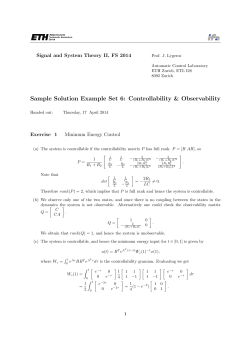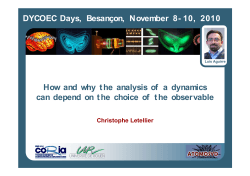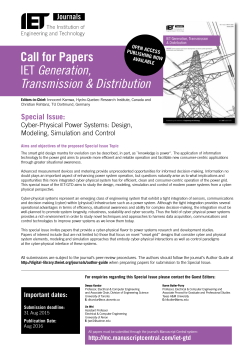
Cyber-Physical Systems - NeCS
NeCS Networked Controlled System Team Research Proposal – Ph.D. Thesis Cyber-Physical Systems: a control-theoretic approach to privacy and security Advisor: Alain Kibangou alain.kibangou@gipsa-lab.fr Co-advisor: Federica Garin federica.garin@inria.fr Team: NeCS http://necs.inrialpes.fr, INRIA Rhône-Alpes, Grenoble (France) Context: NeCS is a joint team of INRIA and of Gipsa-lab (CNRS and Univ. Grenoble-Alpes). Its research focuses on Networked Control Systems, and it involves the analysis and control of dynamical systems with a network structure or whose operation is supported by networks, with particular attention for large-scale networks and cyber-physical systems. As a main application domain, the team studies road traffic networks. Candidate profile: A master degree in engineering or applied mathematics is required. A strong background in automatic control and systems theory is mandatory. Notions of graph theory and/or compressive sensing are appreciated. Topic description: Cyber-Physical Systems (CPSs) are systems in which physical processes are tightly intertwined with networked computing, e.g., sensor networks, industrial automation systems, transportation networks, power generation and distribution networks, water and gas distribution networks. Usually, CPSs are large-scale systems, composed of many simple components (agents) with interconnections giving rise to a global complex behaviour. Interesting recent research [1,2] has been exploring how the graph describing interactions affects control-theoretic properties such as controllability or observability, namely answering the question whether a small group of agents would be able to drive the whole system to a desired state, or to retrieve the state of all agents from the observed local states only. The study of observability is related to the understanding of privacy: from which local measurements is it possible to reconstruct the state? If we impose that some information must remain private, can we design a system that achieves the desired performance without disclosing any private information? Some preliminary works (e.g., [3]) consider the case where the dynamical is some in-network computation (state evolution being numerical and not physical), and the private information is the agent’s identifier. More scenarios are to be studied, involving physical systems. A related problem is observability in the presence of an unknown input [4]. The input can represent a malicious attack, aiming at disrupting the normal system functioning while staying undetected [5]. The best security in CPSs can be obtained by combining classical tools for cyber-security with control-theoretic tools taking into account the physical system, for example, by exploiting the known dynamics of the system to detect inconsistencies in the measurements due to the attack (the undesired input to be detected). Current research on observability and input detection can be enhanced by taking into account sparsity constraints. Sparsity often appears at many levels in CPSs, due to physical limitations in the range of interconnections between subsystems and of communications. Moreover, in the study of security, it is often natural to assume some sparsity of the attacker input, modelling the difficulty to physically disrupt the system at too many locations [6]. The question of observability or input detectability under given sparsity constraints could lead to different answers than the ones obtained in classical control theory, similarly to the compressive-sensing revolutionary approach to signal processing, where non-uniqueness of reconstruction due to low sampling rate can be overcome by taking sparsity into account in the problem formulation [7]. Bibliography [1] Y. Y. Liu, J. J. Slotine, and A. L. Barabasi, Controllability of complex networks, Nature, vol. 473, no. 7346, pp. 167–173, 2011 [2] A. Y. Kibangou and C. Commault, Observability in connected strongly regular graphs and distance regular graphs, IEEE Trans. Control of Networks, (1) 4, pp. 360-369, 2014. [3] F. Garin and Y. Yuan, Distributed privacy-preserving network size computation: A system-identification based method, 52nd IEEE Conf. on Decision and Control (CDC 2013), pp. 5438-5443,. Dec. 2013. [4] A. Esna Ashari, F. Garin, and A.Y. Kibangou, Joint Input and State Estimation for Linear Discrete-Time Networked Systems, IFAC Workshop Necsys'12, pp. 97-102, Sept. 2012. [5] F. Pasqualetti, F. Dörfler, and F. Bullo, Control-Theoretic Methods for Cyberphysical Security: Geometric Principles for Optimal Cross-Layer Resilient Control Systems. IEEE Control Systems Magazine, 35(1):110-127, 2015. [6] A. Teixeira, I. Shames, H. Sandberg, and K. H. Johansson, A Secure Control Framework for Resource-Limited Adversaries, Automatica, 51, pp. 135-148, 2015 [7] D. L. Donoho, Compressed sensing, IEEE Trans. Inform. Theory, vol. 52, no. 4, pp. 1289–1306, 2006.
© Copyright 2025










